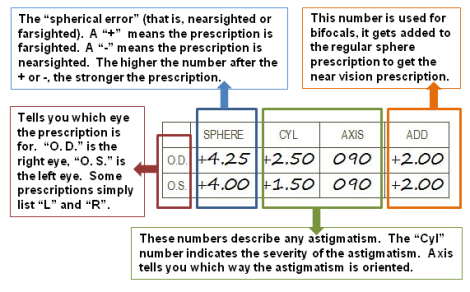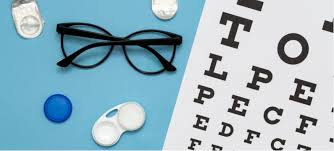Most of you must wondering on ‘how to read your contact lens prescription?’
Your contact lens prescription allows you to purchase contact lenses that match your requirements from optical shop or online suppliers, with specialized power measurements specifically for contact lenses. You need to know your physical prescription with you in order to purchase contact lenses from physical or online shop and also you do need to have a good understanding of what it is. How to read your contact lens prescription? You can find your prescription on the piece of paper given to you by an optician during a check-up. However, contact lens prescriptions can vary in number depending on the brand of the product itself. A written prescription usually includes the following specifications: base curve, diameter, power (or sphere), and then additional figures for Cylinder and Axis if you have astigmatism, and Addition and Dominant figures for presbyopia correction. The prescription for your left and right eye will be listed separately as they may vary.
What OD and OS meanThe first step to understanding your eyeglass prescription is knowing what “OD” and OS” mean. They are abbreviations for oculus dexter and oculus sinister, which are Latin terms for “right eye” and “left eye.” Your eyeglass prescription also may have a column labeled “OU.” This is the abbreviation for the Latin term oculus uterque, which means “both eyes.” Though use of these abbreviated Latin terms is common on prescriptions for glasses, contact lenses and eye medicines, some doctors and clinics have opted to modernize their eyeglass prescriptions and use RE (right eye) and LE (left eye) instead of OD and OS. On your eyeglasses prescription, the information for your right eye (OD) comes before the information for your left eye (OS). Eye doctors write prescriptions this way because when they face you, they see your right eye on their left (first) and your left eye on their right (second).

Below is an example of the prescription that had been given by an optician
What does each prescription figure mean?
-
Base Curve (BC): The base curve determines what type of fit is required for the lens to meet the curve of your eye. This is usually written in millimeters or sometimes with the words: flat, median or steep.
-
Diameter (DIA): The diameter of the contact lens is also written in millimetres and determines the width that best fits your eye.
-
Power/Sphere (PWR/SPH): This figure shows whether you are long or short-sighted and how much correction your eyes require. If you are long-sighted your figure will begin with a + (plus sign) and if you are short-sighted it will begin with a – (minus sign). This will be followed by a number that goes up from 0 in measures of 0.25 dioptres, the higher the number the stronger the visual correction needed.
-
Cylinder (CYL): The cylinder will always be a minus number that increases in measures of 0.25. Much like the power/sphere figure that is shown on all standard prescriptions, the cylinder denotes the extra visual requirements needed for astigmatism and how severe the astigmatism is.
-
Axis (AX): Astigmatism is caused by the irregular curvature of the eye; the axis is a figure which determines the angle of the correction needed in order to see clearly. The Axis is always a number between 0 and 180 degrees.
-
Addition (ADD): If you suffer from presbyopia it affects your near vision, the Addition figure determines what level of correction you need to be able to see clearly at a close distance. This is a number between 0.50 and 3.00, some contact lens brands refer to this as a high, medium or low.
-
Dominant: If you wear multifocal contact lenses or bifocal contact lenses, the correction is determined by a dominant and non-dominant eye, this is the dominant figure usually marked with a “D” and “N” to express which eye is which.
|
Base Curve |
Diameter |
Power/Sphere |
Cylinder |
Axis |
Addition |
Dominant |
|
|---|---|---|---|---|---|---|---|
|
Left |
8.4 |
14.0 |
-0.50 |
-1.25 |
10 |
>+1.0 |
N |
|
Right |
8.4 |
14.0 |
-1.25 |
-1.25 |
180 |
+1.0 |
D |
Below is an example of the prescription listed on the side of the box for 1-Day Acuvue Moist for Astigmatism.
An eyeglass prescription cannot be used to buy contact lenses
Eyeglass and contact lens prescriptions aren’t the same. An eyeglass prescription is for the purchase of eyeglasses only. It does not contain certain information that is crucial to a contact lens prescription and that can be obtained only during a contact lens consultation and fitting. In addition to the information in an eyeglass prescription, a contact lens prescription must specify the base (central) curve of the back surface of the contact lens, the lens diameter, and the specific manufacturer and brand name of the lens. Also, the power of an eyeglass prescription frequently is modified when determining the best contact lens power. This is because eyeglass lenses are worn some distance (usually about 12 millimeters) from the surface of the eye, whereas contact lenses rest directly on the cornea of the eye. An accurate contact lens prescription can be written only after a contact lens fitting has been performed and the prescribing doctor has evaluated your eyes’ response to the lenses and to contact lens wear in general. Let’s make an appointment with us at Malaya Optical Optometrists, we are ready to teach you on how to read your contact lens prescription!
Understanding Contact Lens Prescriptions
A contact lens prescription is a crucial document that allows you to purchase contact lenses that match your requirements from optical shops or online suppliers. It’s essential to understand the components of your contact lens prescription to ensure you get the right lenses for your eyes. A contact lens prescription typically includes the power, base curve, and diameter of the lens, as well as additional measurements such as cylinder, axis, and add. Knowing what each of these terms means and how they affect your vision can help you make informed decisions about your eye care.
Key Components of a Contact Lens Prescription
A contact lens prescription consists of several key components that determine the correct fit and power of a contact lens. These components include:
-
Power (PWR/SPH): Measured in diopters (D), this indicates the degree of nearsightedness or farsightedness. A minus (-) sign denotes nearsightedness, while a plus (+) sign denotes farsightedness.
-
Base Curve (BC): Measured in millimeters (mm), this indicates the shape of the lens that best fits the curvature of your eye.
-
Diameter (DIA): Also measured in millimeters (mm), this indicates the size of the lens, ensuring it covers the correct area of your eye.
-
Cylinder (CYL): Measured in diopters (D), this indicates the degree of astigmatism, which is an irregular curvature of the eye.
-
Axis (AX): Measured in degrees, this indicates the orientation of the astigmatism correction needed.
-
Addition (ADD): Measured in diopters (D), this indicates the degree of presbyopia, which affects near vision.
Understanding these components can help you ensure that your contact lenses fit well and provide the necessary vision correction.
Reading Your Contact Lens Prescription
Reading your contact lens prescription can seem daunting, but it’s essential to understand the different components to ensure you get the right lenses. Here’s a breakdown of how to read your contact lens prescription:
-
Power (PWR/SPH): Start by looking for the power measurement, which is usually indicated by a minus (-) sign for nearsightedness or a plus (+) sign for farsightedness.
-
Base Curve (BC): Next, look for the base curve measurement, which is usually indicated by a number followed by the letter “mm.”
-
Diameter (DIA): The diameter measurement is usually indicated by a number followed by the letter “mm.”
-
Cylinder (CYL): If you have astigmatism, look for the cylinder measurement, which is usually indicated by a number followed by the letter “D.”
-
Axis (AX): The axis measurement is usually indicated by a number followed by the degree symbol (°).
-
Addition (ADD): Finally, look for the add measurement, which is usually indicated by a number followed by the letter “D.”
By understanding these measurements, you can ensure that your contact lenses are tailored to your specific vision needs.
Contact Lens Prescription and Eye Health
Your contact lens prescription is closely tied to your eye health. If you have a high prescription, it may indicate underlying eye health issues. For example, a high prescription for nearsightedness may indicate a higher risk of developing myopia-related eye problems. Similarly, a high prescription for astigmatism may indicate a higher risk of developing astigmatism-related eye problems. It’s essential to work with an eye care professional to determine the best course of treatment for your eye health. Regular eye exams and consultations can help monitor and manage any potential issues, ensuring your eyes remain healthy.
Ordering Contact Lenses
When ordering contact lenses, it’s essential to ensure that you have a valid prescription from an eye care professional. You can order contact lenses from optical shops or online suppliers, but make sure to provide your prescription information accurately to ensure you get the right lenses. Some online suppliers may also offer a free consultation with an eye care professional to ensure you get the right lenses for your eyes. Always double-check your prescription details before placing an order to avoid any mistakes and ensure the best fit and vision correction for your needs.


